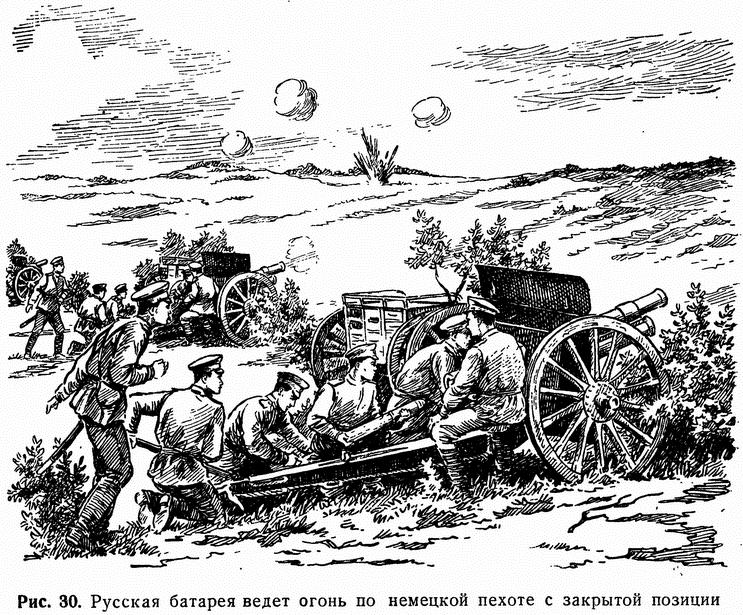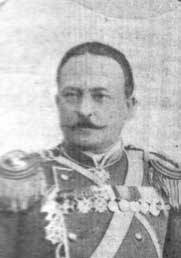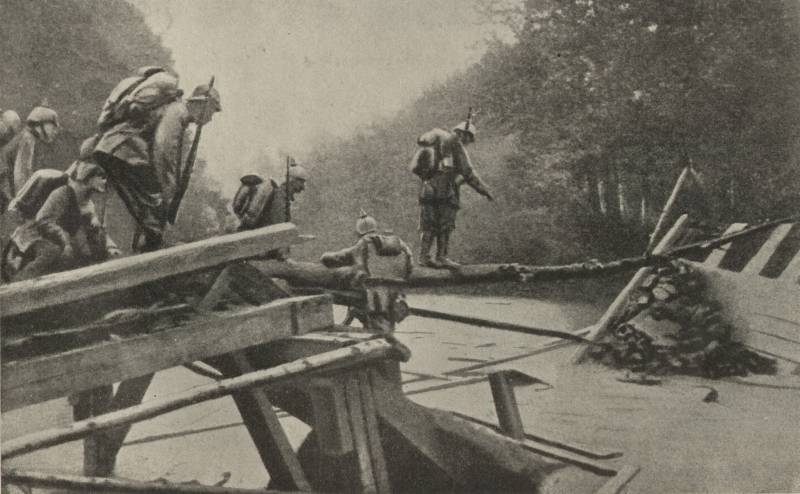Bloody Radymno. Gunners, cavalry and plastuy on the path of the "rink" A. Mackensen
On the night of May 9, the artillery of the 21 Army Corps changed positions, reinforcements approached. The participant in the battles recalled how, at night, in their arms, gunners with incredible efforts pulled out cannons and charging boxes with a ragged 8 — 10-inch shells of the enemy’s position. Horses could not take them out: huge funnels (each one could easily fit a platoon of soldiers) prevented the front end from approaching. The 21th Caucasian Rifle Division joined the 3 Corps and the artillery of the latter immediately opened fire on the enemy. 9 — On 10 in May at Radymno there was mainly a fire battle.
The main blow of the Austro-Germans and the self-sacrifice of Russian artillery
On May 11, on the front of the 3 and 8 armies, the main enemy offensive began. The Headquarters summary reported: "... in the morning of May 11, the stubborn battle on both banks of the Sana'a resumed."
The main blow was inflicted on the joint of the Russian 3 and 8 armies - on the left-flank corps of the 3 (5 Caucasian and 29 army corps) and 8 (21 and 12 army corps) armies . This blow was dealt by the German 11 Army (the German Guards, Consolidated, 10 Army and 41 Army Reserve Corps). From the front, the Austrian 4 Army (Austrian 14 and 9 Army Corps, the German 47 Reserve, Austrian 37 and 41 I Enlisted Infantry, 21 I Infantry and 11 I Amphibious Division) ) attacked the main forces of the 3 (9, 10, 15, 24, 3 Caucasian army corps), and the Austrian 2 (4, 5, 18 and The 19th Army Corps) and part of the forces of the German 11 Army are the main forces of the 8 Army (7 Army, 8 Army, 17 Army, 28 Army Army) of the Russian armies.
The balance of forces (without cavalry, technical and artillery units) in the direction of the enemy’s main strike (the joint of the 3 and 8 Russian armies) is in Radymno.
Russian:
5-th Caucasian Army Corps (3-I Caucasian Rifle Division, 1-I and 2-I Plastun Brigades) of the 3-I Army;
21-th Army Corps (33-I and 44-I Infantry Divisions) 8-th Army.
Austro-Germans:
German 11 Army: German Guards (1 and 2 I Guard Infantry Divisions), Consolidated (119 and 11 I Bavarian Infantry Divisions), 41 I Reserve (81 I and 82 I) ; Austrian 6-th Army (39-I Honored and 12-I Infantry Divisions) corps.
In these battles, the 21 Army Corps suffered a heavy defeat, having suffered significant losses (primarily during the retreat under enemy artillery and machine gun fire beyond the San River). An Austrian source testifies: "Hundreds of Russian corpses were in the river, and thousands were captured." But the adversary’s success was not cheap. The most fierce battles were fought by the Prussian guards at Vetlin and Bobrovka, the 41-I reserve corps and the 39-I persecuted infantry division at the Island - Zagrod.
Transmitting the impressions of the May 11 battle, an eyewitness recalled how the combined Austro-German forces carried out desperate attacks on the entire front, especially emphasizing the Russian position at Radymno. As under the tip of a scythe, the Austro-German infantry lay in rows from the fire of Russian artillery concentrated at Radymno - the latter covered with a continuous layer of steel the entire visible space, tearing off the trenches and instantly unrecognizable changing the terrain under fire. The pillars of black smoke, merged together, clouded the visible world - and as if a black blanket was thrown over to Russian positions. Only bright flashes, as if the lights of tearing rolled. A continuous rumble and glow from the burning villages completed the picture of the battle.

The Austro-Germans are pushing ever harder, more insistently, their attacks. And the fire of Russian guns beyond San begins to weaken: there are not enough shells, and the transportation of the latter is almost impossible. The batteries, which were almost in open positions, shut off one after another. The Russian infantry, half-destroyed by enemy fire, is left to its own devices, and, under an insane hail of steel and lead, desperately resisting, leaves. The front fenders gallop across completely open terrain to silenced guns, but the Germans have already advanced so far forward that under their machine-gun crossfire, the front fenders.
The enemy was able to reach the artillery positions of the 33th artillery brigade, which suffered heavy losses in people and equipment. The front-line soldier recalled that, having remained without the front lines, and, accordingly, without hope of salvaging the guns, the surviving soldiers of the 5 battery are leaving, taking gun locks with them. Combat-5 Lieutenant Colonel A. V. Vasiliev captured by the Austrians.
The personnel of the 2 battery basically died, firing from revolvers from the pressing Germans. The battalion-2 captain N. N. Volkov, seeing how the enemy infantry flooded over the battery, rushed from the observation post, taking with him a small group of foot soldiers met on the road - and led them into a desperate counterattack on his battery.
The 6 battery, hidden behind the garden, held out for the longest time - it shot down a German attack with a quick fire. But the Germans are already approaching the garden. And on the shady alley frontiers rush - this is the only route hidden from the eyes of the enemy. The guns were removed on time - the German infantry enters the position of the 6 battery.
Plast feat
The commander-in-chief of the armies of the Southwestern Front, artillery general N. I. Ivanov ordered the commander of the 3 Army to support his neighbor - the 21 Army Corps of the 8 Army, which was in critical situations. But since the adjacent 5-th Caucasian Army Corps (see further) he himself was in a difficult situation, from the structure of the latter only the 2-I plastonic brigade was sent to help.
And on the 12 of May, the 6 of the Plastun battalions attacked the enemy, breaking through the positions of the 21 of the corps. B.V. Wevern recalled how his (now consolidated) battery supported the attack of the Plast. Shaggy black hats, Circassians, black cloaks rolled over his shoulder and silver daggers - this is the impression of an artilleryman from the swift attack of the plastunas attacking in the open field. The enemy fired heavily - and the field was full of black spots of the dead and wounded. But the plastunas will not swoop down and turn back. Enormously bursting enemy shells, smoke clouds the field. And the chains of plastuns are rolling forward faster and faster! Happily taken!
But then the plastunas were ordered to retreat - again under fire and through the same field. The retreating plastunas encircled several hundred captured Germans in a tight ring, endure their wounded and weapon killed. The artillery of the enemy beats both their own and others - plastunas and prisoners fall. About 6 returned from 2 battalions.
As a result, the heroic attack of the Plastun brigade did not lead to a turning point in the situation.
21-th building moved to the right bank of the river. San, but with the efforts of the plastunas and units of the 11 Cavalry Division, the front of the corps was restored.
11 I Cavalry Division and 6 I Battery. The enemy did not pass
I. F. Rubets wrote: “The 11 I Cavalry Division, under the command of General Velyashev, in the Radimno region ... attacked the advancing masses of the German infantry. The enemy was stopped and our infantry was fixed. The 11 Dragoon Riga Regiment suffered heavy losses during the attack. ”

In the military journal of the 12 Don Cossack Field Marshal, His Excellency Prince Potemkin-Tauride Regiment, there are the following lines: “... the regiment (as part of the 11 Cavalry Division) participated in battles on the right bank of the Sana'a, for the defense of the river. R. Lyubachevka and Sklo. These battles were of great importance for the further course of events, especially the battles at the village of. Zaleska Wola, 13 on May, when the advance of the Austro-Germans was stopped. "
The battles at the front of the 21 Corps flared up with renewed vigor on the 13 May. As B.V. Wvern recalled, by morning of the village, in the center of which was der. Volya-Zalesskaya, the place of the last night of the 6 battery, were densely occupied by the Germans. The shells of the latter with the first rays of the rising sun buzzed in the air, showering cavalrymen and plastuns with a hail of metal. The terrain is absolutely flat, but if the Germans hide the villages, the Russians are completely open. The officer was comforted only by the power of his 14-gun battery - giving a line of continuous fire more than a quarter verst wide. The rate of guns, coupled with a relatively small distance gave a hurricane of fire. But the Germans barely showed up, bombarding Russian shells.
The head of the 11 Cavalry Division, having informed the headquarters of the corps that he was no longer able to stay, received permission to withdraw. It was ordered to withdraw from the position and the 6-th collective battery. The cavalrymen began to retreat, but as soon as they got up from the trenches, they underwent powerful fire from the enemy, while the German infantry hiding in the villages rushed to attack on a clear field.
The battalion commander, realizing that under the circumstances, the retreat of the cavalrymen and plastunas would be too difficult, did not fulfill the order to withdraw from the position and withdraw. The moment has come when the 14-gun battery could show itself. And she worked almost without interruption, as with a card fire. Minor breaks were obtained only when turning the battery fan. Two German batteries rolled out at a gallop - directly into the open. As a result, they laid 2 in huge heaps, not even having time to get off the frontlines. The surviving Germans tried to hide in the village buildings - on which the fire of the Russian battery was transferred.
The 14-gun battery surpassed itself: as if the guns were machines, rather than living people, whose accuracy and speed of operation were almost perfected. Neither the howl and crack of flying enemy shells, nor the heat of red-hot cannons could break the pace and correctness of the combat work, and only the sweat that flowed abundantly from their faces and the excited gleam of their eyes indicated that living beings were standing at the guns.
As a result, the retreat was canceled, and the battle fell silent. The Germans on this day refused to repeat the attack. And in the evening came an order to withdraw.
To be continued ...

Information